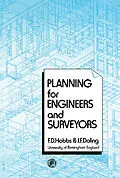Planning for Engineers and Surveyors provides an understanding of the land use and transport planning context in which the work of engineers and surveyors was carried out. It attempts to explain what the planners of land use and transport did and why. It describes the problems which planners face, the reasons why they emerged, the techniques used to develop plans, and the political as well as the technical nature of planning. The book begins with a definition of planning and a review of different popular beliefs about planners themselves. This is followed by separate chapters on the development of the planning system, including its history, institutional framework, and laws; the impact of social, economic, and physical environment on planning; and transport and communications planning. Subsequent chapters cover features of the planning process which are general to planning at different levels and of different sectors; the development of planning policies; the design implications and characteristics of a number of land uses; and the political character of planning.
Inhalt
List of Illustrations
1. The Nature of Planning and Planners
Introduction
The Definition of Planning
The Planners
2. The Development of the Planning System
The History of Planning
The Renaissance Period
The Industrial Revolution
The Second World War
The Progress of Planning since the War
The Institutional Framework
Central Government
Local Government
Regional Planning
The Present Legislation
Structure Plans
Local Plans
Transport Policies and Programs
Housing Investment Programs
Development Control
The Community Land Act
Management and Staffing in Local Authorities
The Structure of Local Authorities
The Structure of Planning Departments
The Staffing of Planning Departments
3. People, Land and Resources
Introduction
Population
Population Trends
The Death Rate
The Birth Rate
Migration
The Number of Households
Housing
Socio Economic Characteristics of the Population
Employment
Industrial Structure
Characteristics of the Employed Population
Unemployment
The Use OP Land: Urban Areas
The Growth of Urban Areas
New Towns
The Present Extent of Urbanization
The Internal Structure of Cities
The Use of Land: Rural Areas
Agriculture
Forestry
Protecting the Countryside
Natural Resources
Energy
4. Transport and Communications
Introduction
The History of Transport Technology
The Organization of Society
Characteristics of the Transport System
Technical Characteristics
Transport Modes
Transport Efficiency
Capacity
The Costs of Transportation
Monetary Costs
Resources
Accidents
Environmental Costs
Policies for Transportation
Traffic Restraint
Transport Developments
Social Factors
5. The Planning Process
Introduction
The Rational-Comprehensive Model
The Planning Cycle
Systems Analysis
The Formulation of Goals
Information
The Generation of Alternative Plans
The Evaluation of Alternative Plans
Implementation
Monitoring
Limitations of the Rational Comprehensive Model
Satisficing
Incrementalism
6. The Development of Planning Policies
Introduction
Problems of Forecasting
Uncertainty
Self-fulfilling Forecasts
Self-defeating Forecasts
Extrapolating Trends
Population Forecasting
The Elements of Change
Time Series Methods
Ratio Methods
Cohort Survival Methods
Housing Stock Models
Housing
The Number of Households
The Number of Houses
The Amount of New Building
Employment
Retailing
Information
Methods
Recreation
Recreation Standards
The Locational Dimension
Transport
Forecasting Vehicle Numbers
Trip Generation and Attraction
Trip Distribution
Modal Split
Trip Assignment
Accessibility Indices
7. A Comprehensive Land Use Model the Design Process
Introduction
General Aspects of Design
Social Factors
Aesthetic Aspects
Physical Factors
Economic and Administrative Aspect
The Site
Residential Development
Planning Controls
Housing Standards
Economic Controls
Market Constraints
The Form of Development
Industry
Site Requirements
Layout
Commercial Areas
Traffic Management
One-Way Streets
Pedestrianization Schemes
8. Politics and Participation
Introduction
The Nature of Land Use Conflicts
Accessibility
Compensation and Betterment
County-District Conflicts
The Political Character of Planning
The Elected Representatives
The Officers
Pressure Groups
Public Participation
Legislation
Implementation
The Planning Process
Recent Experience
Future Directions
Index
